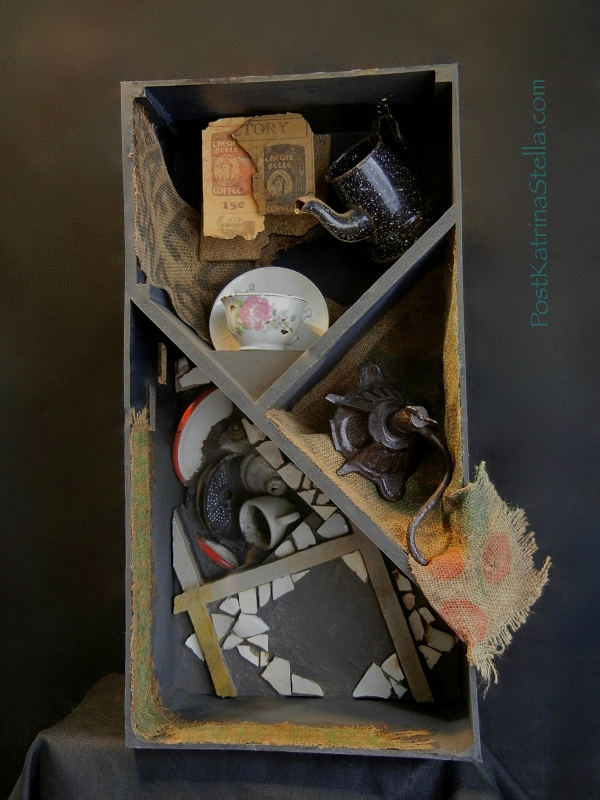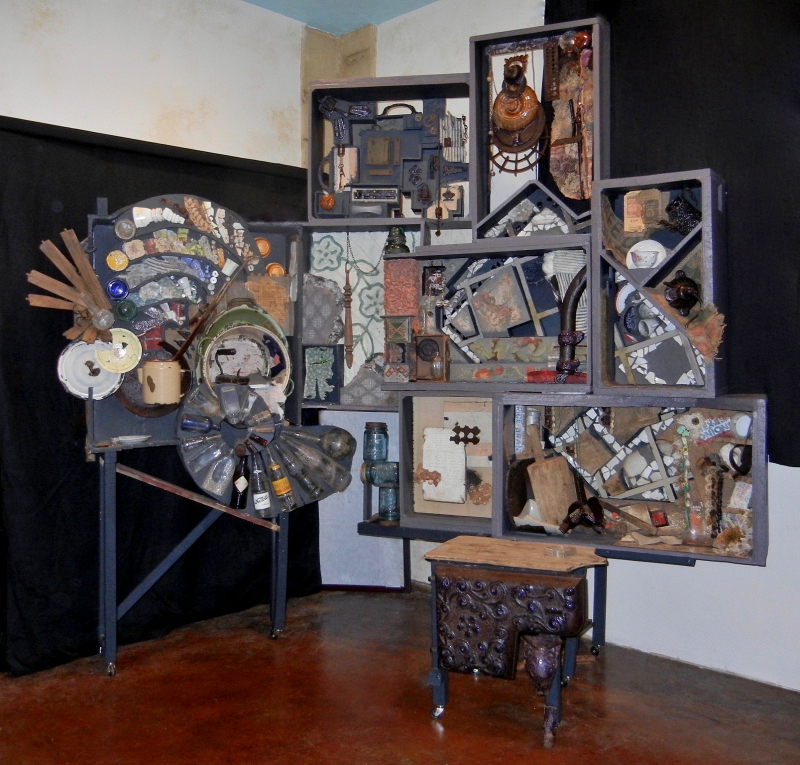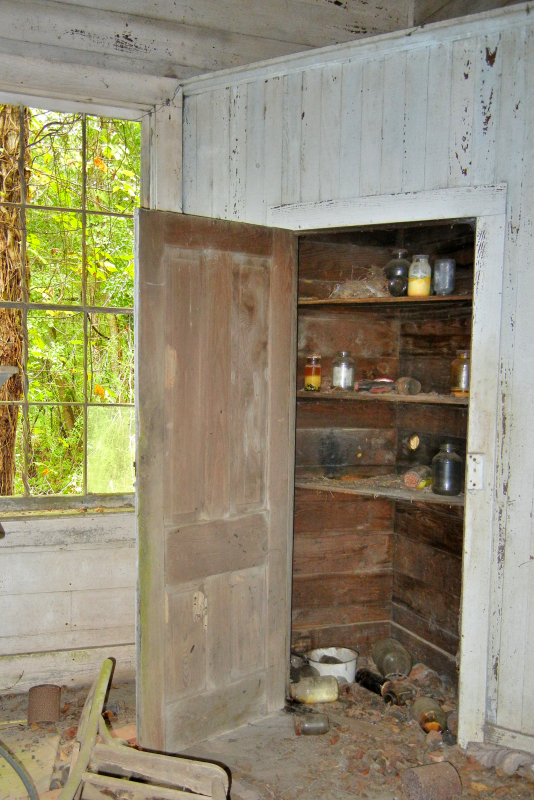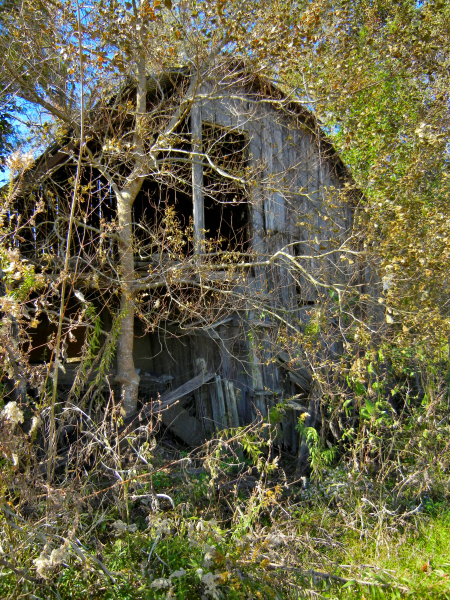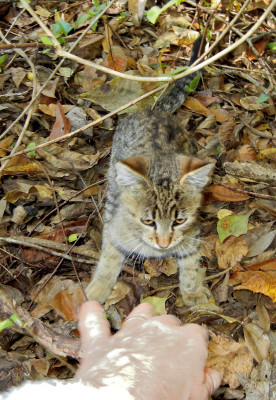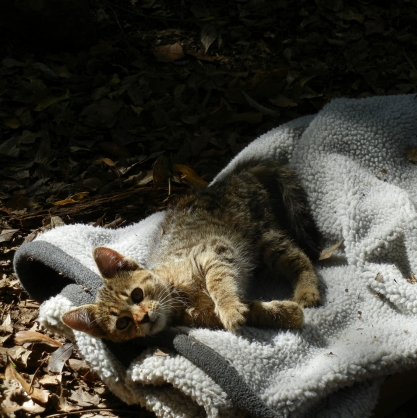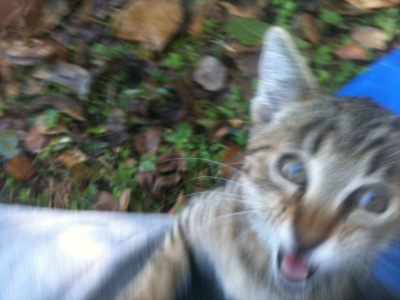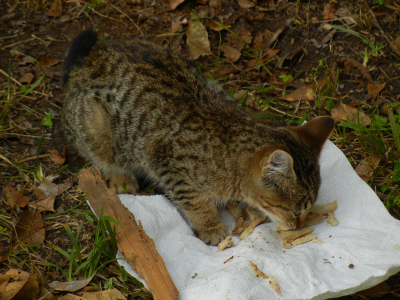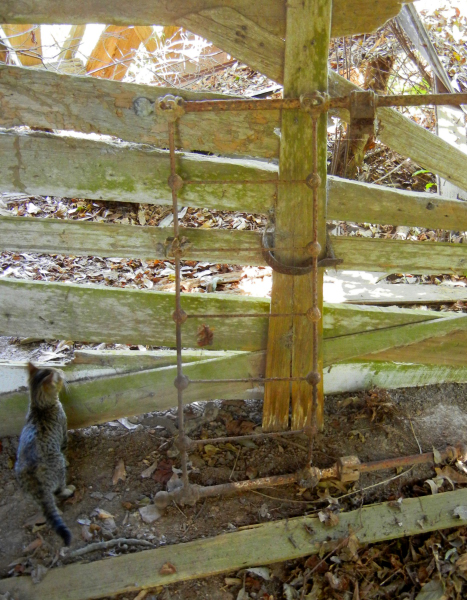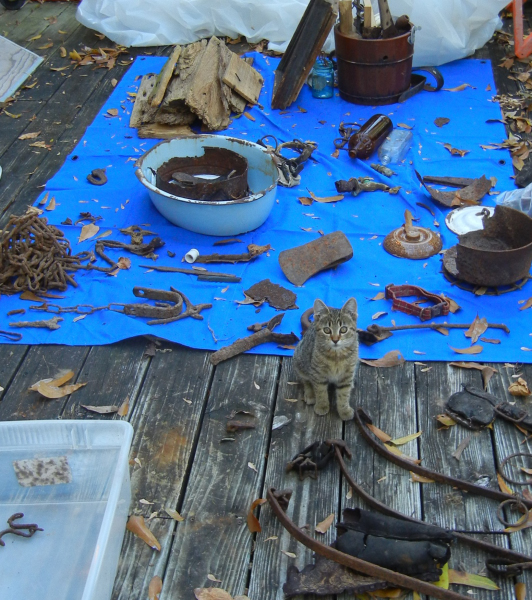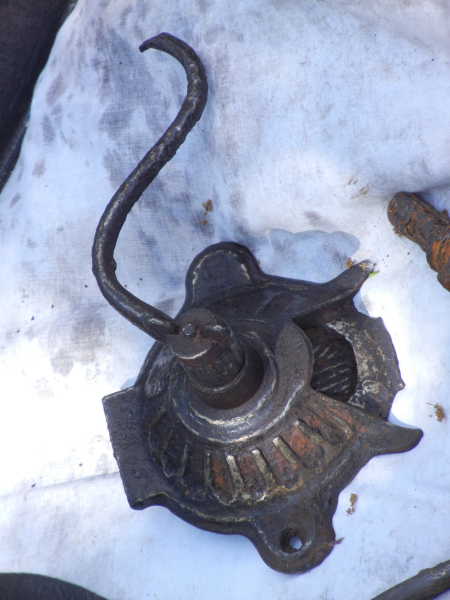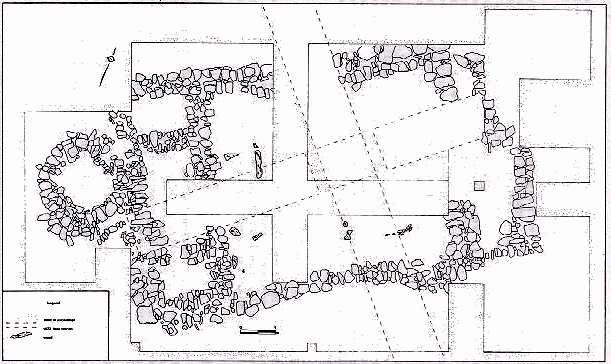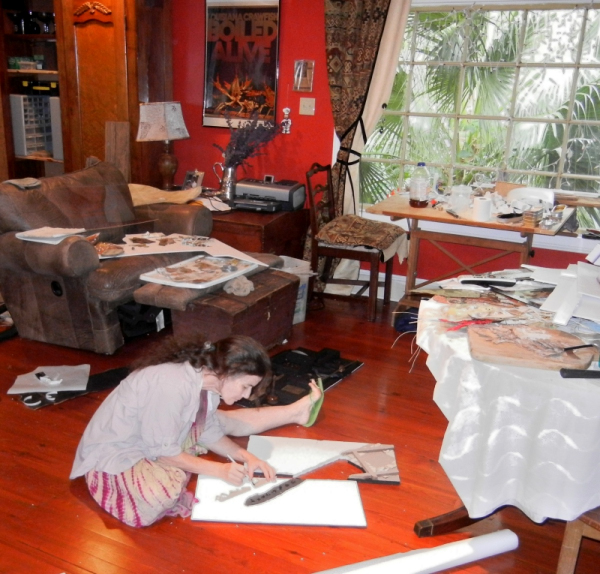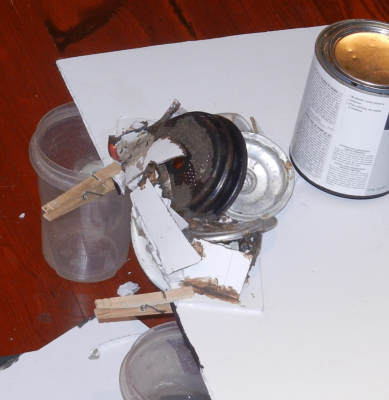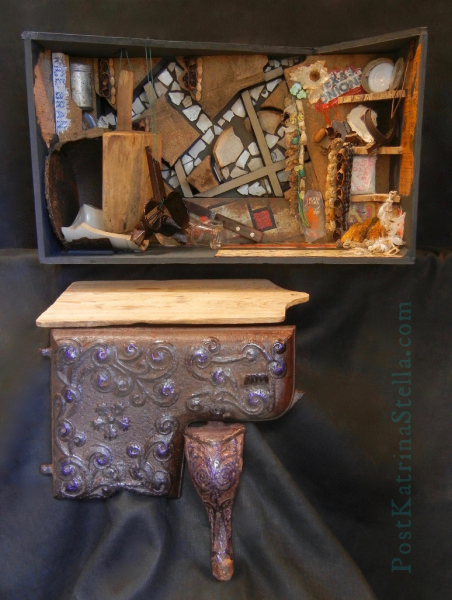- top – Burlap sack fragment “Café do Brasil”
- . . . 1930s newspaper fragment and copy, Creole Belle coffee
- . . . Graniteware coffee pot
- . . . China coffee cup and saucer
- center right – Charles Parker no. 60 coffee grinder
- . . . fragment, same burlap sack, bean and leaf design
- bottom – collection of many coffee pots and a demitasse cup
- [inset w/white china shards – represents archaeological excavation of the Belleisle Acadian house foundation in today’s Nova Scotia, explained in its own post]
Some parts of this assemblage are as straightforward, requiring little explanation, as others are complex – stories all over the place. The coffee section is simply that, all about coffee. Good strong café au lait is a part of the old Louisiana world, and everywhere on the Thibodeaux property, there were things having to do with coffee. . . . . in Thelesphore’s kitchen pantry,
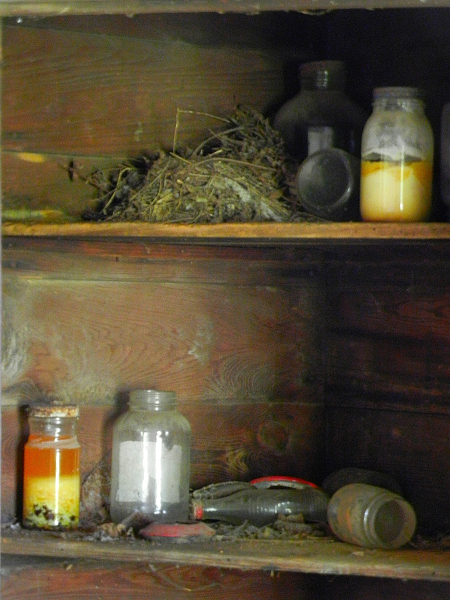
. . . on his bedroom walls,
. . . outside the kitchen window,
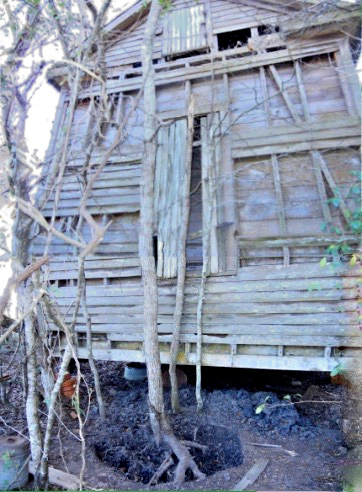
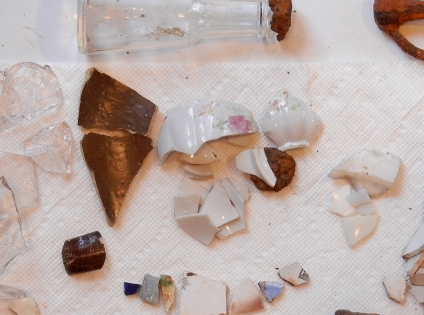
. . . and in his shed out back with the trash midden next to it.
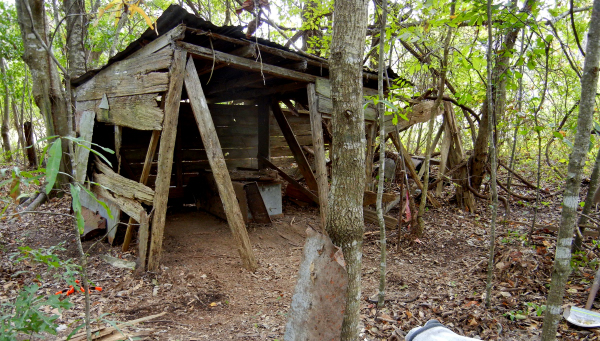
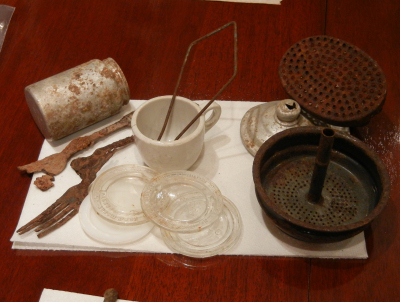
And then there was the property of Thelesphore’s brother, Paul Hypolite, across the street. A newer house now rested where his house had been, but his outbuildings and their contents remained, including coffee things . . .
. . . in his barn,
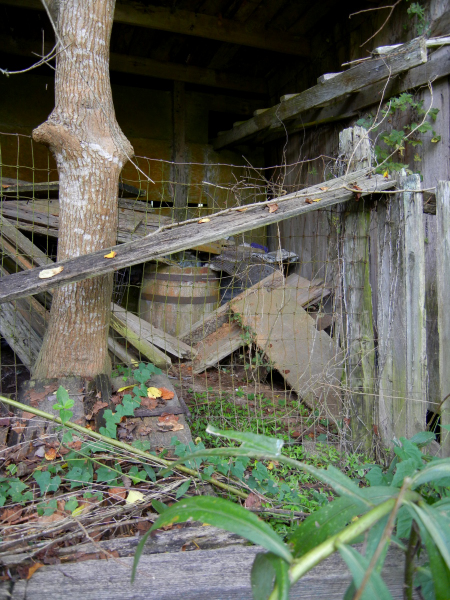
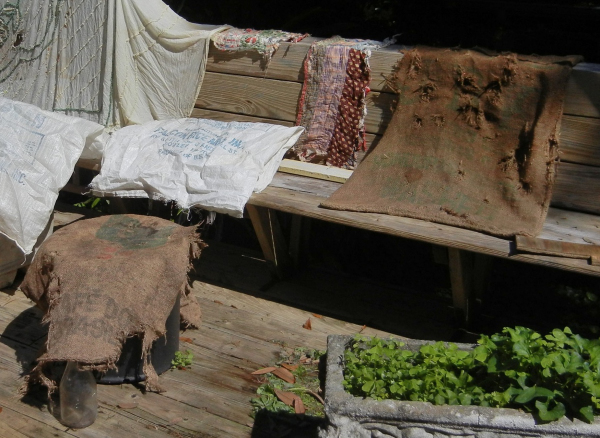
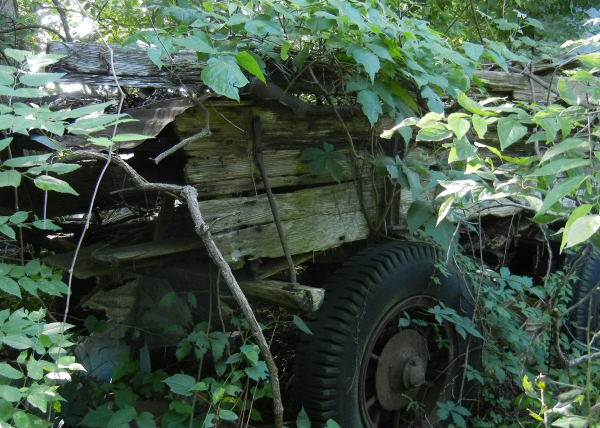
. . . under his wagon,
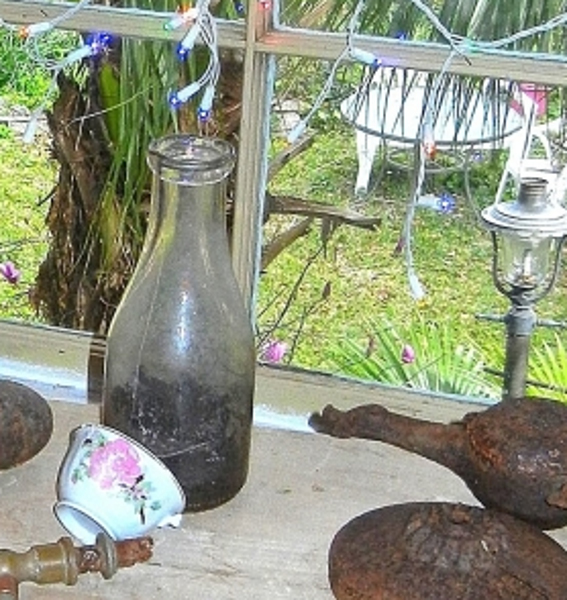
. . . in his big shed,
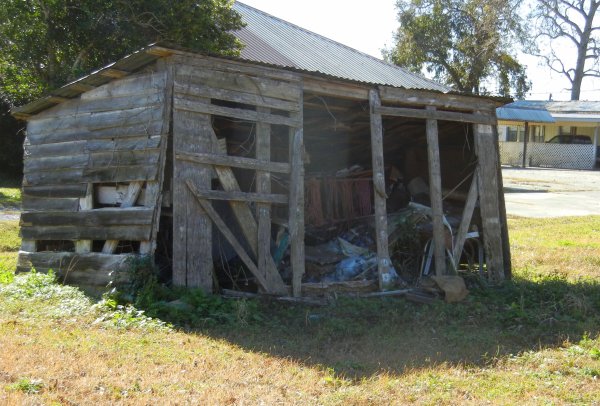
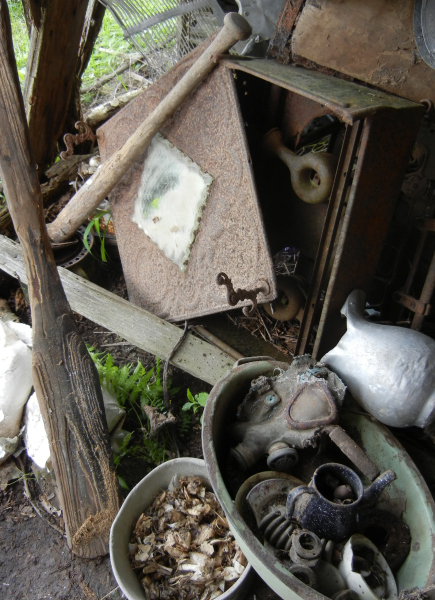
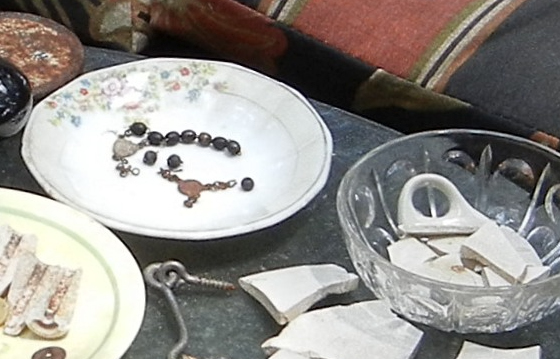
… and in his small shed.
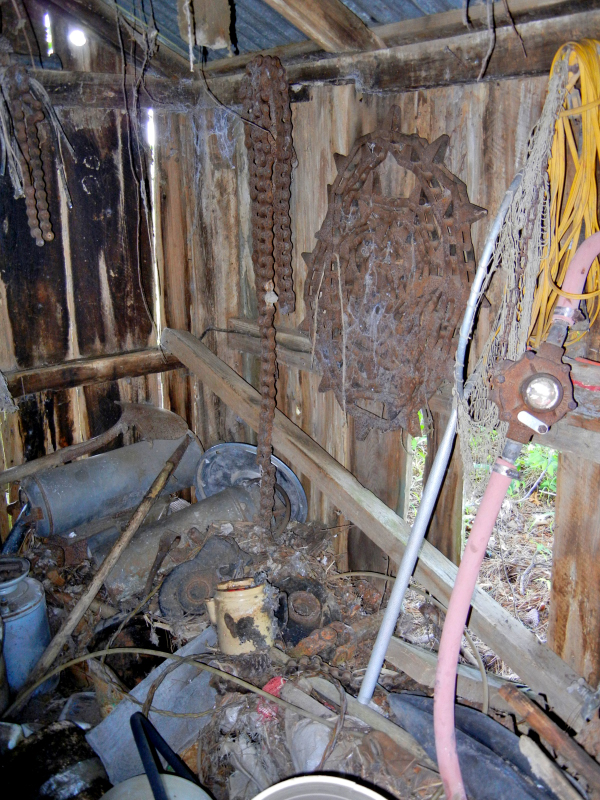
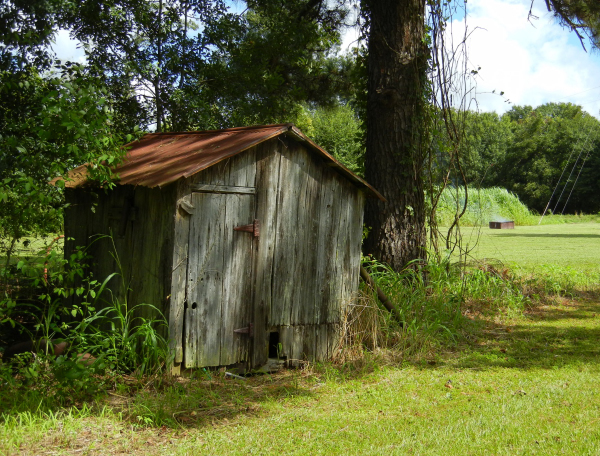
Okay, a bit of orientation here. See the shot of Paul Hypolite's shed in the shade of the pine tree, with a stand of sugar cane at right, in the distance, and a grove of oaks behind that? Thelesphore's house is in those trees, though you can't see it for the shadows. And FYI, the lighter green patch of sugar cane in front looks to be near ready for the November harvest; you want to get it up before the first freeze. There's no indication of the quiet, 2-lane highway that runs between the trees and the cane field, but it's there. You can roughly tell the property line, perpendicular to the road, from the shed and the pine needles. The camera's at a 45° angle, looking across the neighboring property to the next property after that, Thelesphore's, all three belonging to descendants of Onezime and Elizabeth's 8 children .
— ☙❦❧ —
Now, let’s go back across the street to Thelesphore’s, and I’ll introduce you to the other two eponymous entities to whom this post is dedicated, both of them as ‘everywhere’ as coffee things were, one being delightful, the other hellacious, with nary a hint of ‘in between’ to be had.
I met the Thibodeaux gang on Labor Day weekend of 2014 and started going over with Sylvia for long weekends about every 6 weeks, staying with Josie and digging. By Thanksgiving, Bayou Teche was seeing temperatures in the 20s, and when I first pulled into the grassy open patch behind Thelesphore’s, between his shed and the remnants of my gr-gr-grandfather’s fence, this is what I saw, huddled up in a sun spot.
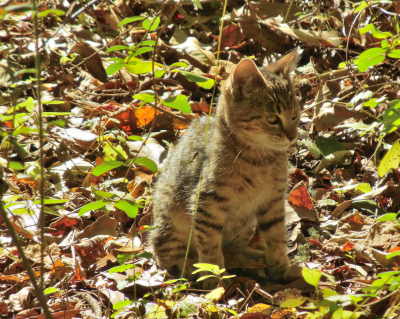
I’ll let the captions take over from here
Well, this little baby had belonged to someone, was raised and loved by people. That whole weekend, I walked up and down the highway, knocking on doors . . . “Are you missing a kitten? You want one? Has anyone around here had a litter of kittens recently?” No, no, and no. But this kitten had been well-fed and had never hunted a day in her life; she’d been without food for days; her ribs told me that. She also drank a whole cup from my water jug. Did she not know there was a bayou just down the slope? It occurred to me that my gr-gr-grandfather’s land, the square from the highway down to the bayou just 40 feet to the side of Thelesphore’s house, was one of the few patches of fully-wooded, bayou-front land for miles either way that hadn’t been developed. Had these woods been specifically targeted? Had she been brought here, then put out by the side of the road by someone? “Here, this is good. Water, an abandoned house, a big patch of woods with lots of mice. She’ll learn”. Put out into a foreign world of danger and fear, not knowing why life as she knew it had suddenly disappeared, the cold, then within hours, the hunger, and then the loneliness that would linger for years of remembering what life had been like, those first fleeting weeks of her life, when she’d had a family who played with her, held her, and made her feel safe… until they didn’t. I couldn’t bare to think about it. Now as I write this, I still can’t.
Maybe that’s not how it happened, and she did somehow just get lost.
After several hours, I saw Raymond from next door (Paul Hypolite’s grandson) and he consented to taking me across the street and showing me his grandfather’s place, his barn and sheds. But I had a problem. Little furry girl was following me everywhere, and was now running after us toward the highway we were about to cross, a lone two-laner that passed through fields and farmhouses as it followed the bayou, and was frequently dotted with the bodies of pet cats and dogs. So I zipped her in my coat and brought her with us, hoping she wouldn’t panic and leap out in the middle of the highway. She didn’t, and from the time I put her down on the other side, she never left my side, exploring everywhere Raymond brought us. I begged Raymond to take her; told him he needed to take her in. “No… I… don’t!”
She was just as insistent at the end of the day, running after me when I was trying to leave. I couldn’t back the car up fast enough to keep her from getting under the wheels again. So I brought her home (only two doors down) so that Josie could meet her, and figured I could walk her back before nightfall. I always quit and headed back to Josie’s early enough in the day to be able to wash all the day’s stuff under Josie’s hose in the carport, something I loved doing, figuring out what things were as they emerged from beneath clots of mud, scrubbing everything down to their clean surfaces and details. Don would come from across the street, and between the trio, they’d often be able to identify things for me.
Josie is not much of an animal lover and doesn’t allow animals in her spotless, well-ordered house. But I’d brought a chair out for her to join us outside while I cleaned things, and I think she was a little charmed when I was stooped over something, scrubbing, and the little baby jumped up on my back and perched on one shoulder, looking down to see what I was working on.
So instead of walking the kitten back to Thelesphore’s house, precious Josie told me I could let her spend the night in her laundry room, which was at the back of what had once been an open driveway that my bedroom window had looked out over. It now looked into the laundry room. That window. Little furry girl couldn’t understand why she couldn’t get to me. For an hour, she rubbed against the screen and cried, standing on the dryer below my window. More than once I teared up, but she was safe. I wouldn’t have slept knowing she was back under Thelesphore’s house, shivering, and thinking maybe she’d find a better place . . . maybe at a house across the highway.
The next day at Thelesphore’s went much like the first, her watching what I was doing, or sleeping in her ‘bed’ in my inside-out fuzzy coat, or darting up and down trees after things, or eating (I always bring ice chests of sandwich makings with me on these jaunts).

The agenda that day was to try to figure out how to get to the patch next to the shed which everyone said had been the trash midden for as long as they could remember. It was thoroughly inaccessible, covered by an old wringer washer that had been grown into, around, then back out of again by a vine that was a good 6 inches in diameter by the time it turned upward toward the canopy to get some sun. I spent half a day pondering it, raking the leaves away from it to see just where the trunks emerged from the ground and how many vines I was dealing with. My machete would have taken me a week and my tree saw just got gummed up with the juices. There was no breaking it; I swung on it too many times, jumping from on top of the washer.
I’ll just leave you there for a minute, our heroine frozen in mid-swing, and give you a quick glimpse of how the trip ended.
Well, I’ll tell you what’s next. Unfreeze our heroine, send her and her new furry friend back to New Orleans, and then let her figure out why she’s always itching with a rash after she comes back from these trips. Poison ivy. It took me awhile to put 2+2 together, but after this trip with the kind of exposure I’d had, I had a complete systemic reaction. All those 6 inch-thick vines? . . yep. So I did alot of googling on how to remove poison ivy in the woods (and how not to; bad stuff!), bought some hazmat suits and the recommended chemicals, and the next time I rolled into Breaux Bridge, stopped at an equipment rental place and got a gas-powered chain saw on an extension pole.
I’d thought I’d have to sacrifice the whole weekend to its removal, but the chain saw went through it like butter. I stacked 4′ logs of poison ivy at a safe distance (you can’t burn it, the smoke can kill you!), painted the stumps with the chemical, then covered them with ziplocks taped tight with hot pink duct tape that I’d have no trouble finding and tracking throughout the growth seasons. I still had several hours of daylight with which to explore what had been underneath the wringer washer, and I so wish I could tell you that I then penetrated a wonderland of artifacts from all the way back before the house was built, when all there was was the bousillage hut I’d been told had been right around there, the hut I think may have been built by Thelesphore and his older brother Oneziphore in the late 1870s, when they reached their late teens and wanted a garçonniere of their own. But other than a few interesting finds near the surface, I ended up hitting an impenetrable layer of tree roots curiously lacking in even a hint of anything man-made. Still, of the few pieces I found there, my favorite ‘coffee thing’ was one of them.
Okay, let’s back up to “… and the next time I rolled into Breaux Bridge”, because the next time I rolled into Breaux Bridge, I not only had hazmat suits and poison ivy killers with me, but I had Liddubit, as her name turned out to be. Besides the name’s obvious derivation, Sylvia decided that Liddubit, like Lilibet, was a diminutive of Elizabeth, the name of Thelesphore’s mother, and that’s what she called her.
When we got back to Thelesphore’s house, Liddubit knew right where she was. She was a bit timid at first, staying in her new bed right there where I was working, but eventually she ran around and played, always coming whenever I called her.


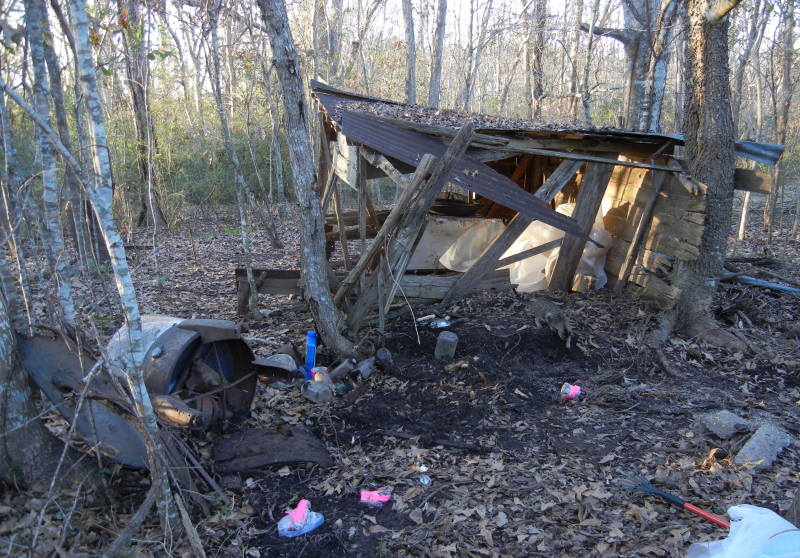
She even helped find the piece that ended up being my favorite, which in turn decided the tone of the coffee sculpture section. . .
. . . which brings the story of the coffee, the kitten, the poison ivy, and me to a close and opens the story of the making of the sculpture. History lovers who aren’t artists or builders, or just aren’t interested in the process of making an assemblage or found-art sculpture, best git while the gittin’s good, because this was almost too dry even for me. And I LOVE how this piece came together.
Sculpture process: ————————-
Funny how memory plays tricks on you. I just finished telling you that finding the coffee grinder was what dictated the design of the coffee sculpture, but looking back over my photographs and the sequence of events, this isn’t so at all. I found the grinder in Thelesphore’s trash midden the day after clearing the poison ivy, in early March, when the whole assemblage was still designed to stand against a wall, seen only from the front. But the coffee sculpture only came about as a function of the Acadian excavation inset that had to take up its lower half. And the Acadian house excavation, together with its African counterpart, only came about when I had a two-sided design. And I didn’t change my against-the-wall design until the Breaux Bridge library, where I’d been hoping to exhibit the Thibodeaux assemblage, told me that the assemblage had grown too big, that they couldn’t sacrifice that much wall space needed for book shelves, and could I make it free-standing, so it could be in the middle of a room. And that was in July of ’15, 3 months after I found the coffee grinder.
Actually, I remember it as one of those fun ‘Aha!’ moments. The minute I had a two-sided design, something with binary potential, I saw in my head the Belleisle house foundation diagram from my favorite excavation up in Nova Scotia, and thought, “wouldn’t it be something if I could find an African counterpart, put them opposite each other, large, woven through and across half the sections of each wall, like a jacquard weave in one pattern with a print of another pattern superimposed onto it. They could depict what the two homes might have looked like, the one that Onesime’s ancestors in 1760s Acadie (Nova Scotia) had been evicted from by war with Britain, and Elizabeth’s ancestors in 1790s Congo, Africa had been kidnapped from by the slave trade.
Sure enough, my photos from between March and July showed that a section devoted to coffee wasn’t yet a twinkle in my eye.
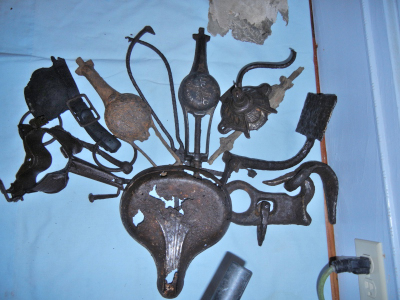

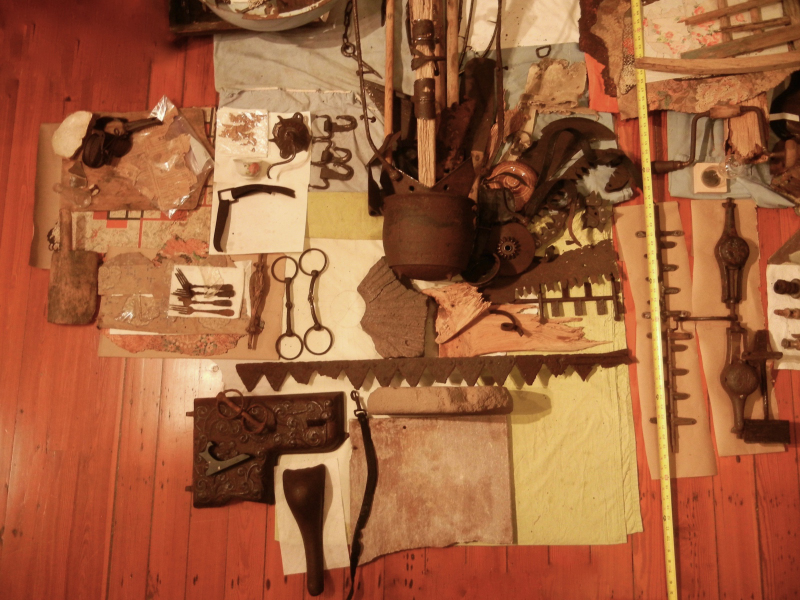
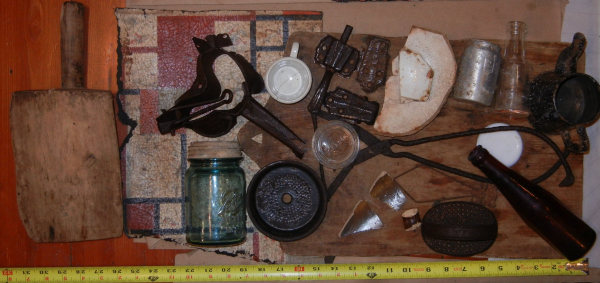
So if the grinder was not the driving force behind the coffee sculpture, what was? Honestly, I don’t remember, but again, I think my photos do.
Laying out the Acadian foundation was simple enough using white china shards and black tar chips. I made it large so that it would span several sections, which meant that the design of the sections involved, and the artifacts they’d contain, had to be coordinated simultaneously.
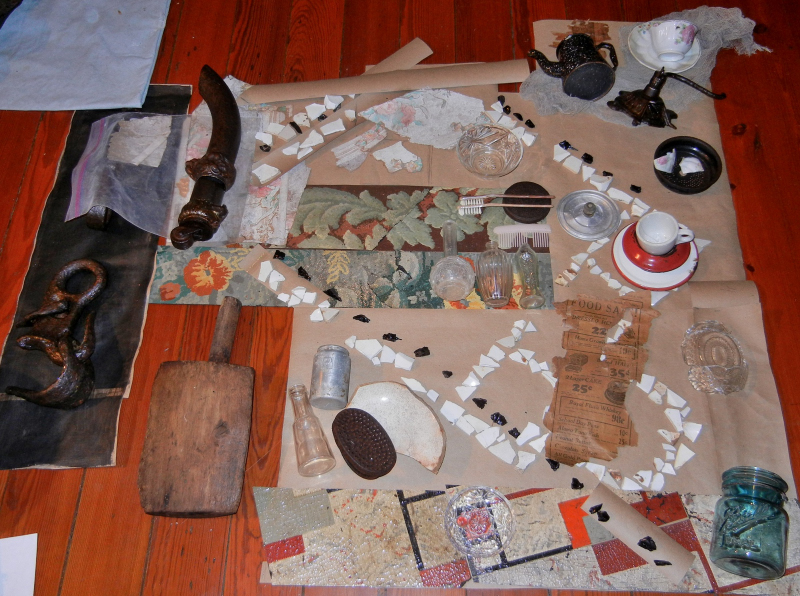
I figured that I’d design the kitchen sculpture to go at the bottom to incorporate the excavation’s round oven, such a signature feature of Acadian architecture, and the bedroom section would go at the upper left, at the side of the house farthest from the busy kitchen, dining, and otherwise utilitarian area, as well as the cellar steps. It was the cellar cavity and stairs that were going to be a trick. Something could be put in the cavity, half-buried below the level of the china shards. But what artifacts worth including would I be willing to half-cover up?
Meantime, coffee things were becoming one of the most numerous artifacts, enough to warrant its own segment, and putting it beside the bedroom section where it would contain the cellar at the right of the excavation would keep coffee on top of the kitchen as an offshoot. The iron coffee grinder though, being one of my favorite pieces, deserved to be showcased without a lot of design and distraction. At the same time, though, the sheer number of coffee-related pieces indicated a significance to the culture that merited representation. It turned out to be something in the bedroom section, not related to coffee at all, that tied the whole thing together. The first weekend in September, after I thought I’d had the whole bedroom section laid out, I found the moss mattress hiding under the stack of bent-over mattresses in Thelesphore’s bedroom that had collapsed in on itself and half disintegrated into something powdery that I avoided breathing on, let alone turning over. But one brave day, I did, and found the moss mattresses beneath it all, still semi-encased in its blue-and-white ticking.
I set Liddubit to work on the little graniteware coffee pot and china cup. She needed to sleep on it, though, and I began recreating the moss mattress, which unfortunately had to go where half the excavation’s cellar site was supposed to go. The cellar cavity was supposed to be split between the bedroom segment and the coffee segment, shared between both, but now the coffee section would have to bare most of the task. By the end of that month, my photos show me that while I was mulling over how to put the moss, ticking and pillow feathers together where half the cellar cavity section was supposed to have gone, I had come up with the idea of burying some eliminated coffee pot parts in what remained of the cellar cavity, and was experimenting with ways to squish several pieces together into the cavity, far enough down to really look the way they would if an excavation had exposed only the top half.
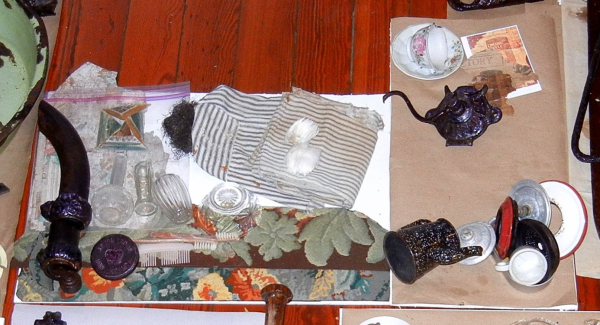
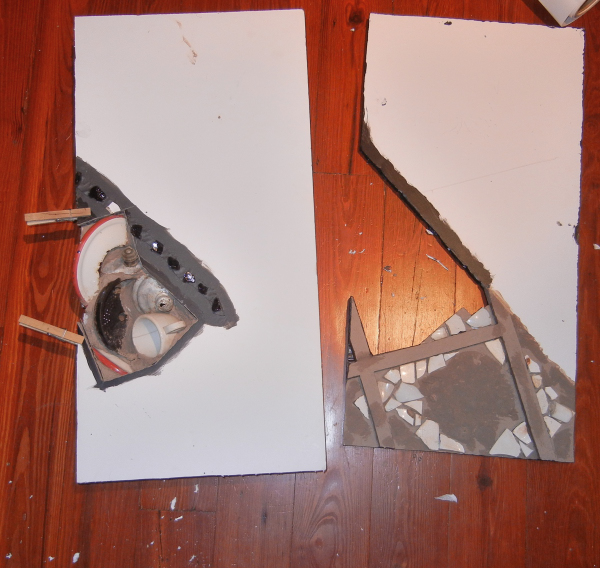

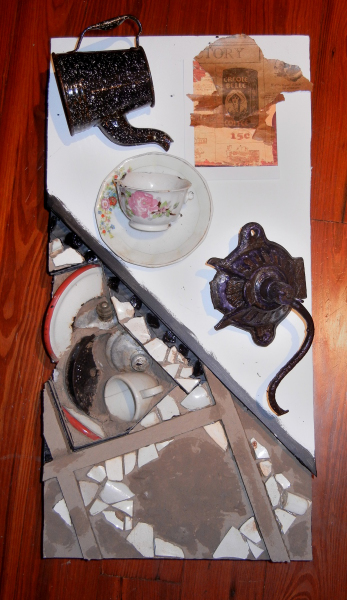
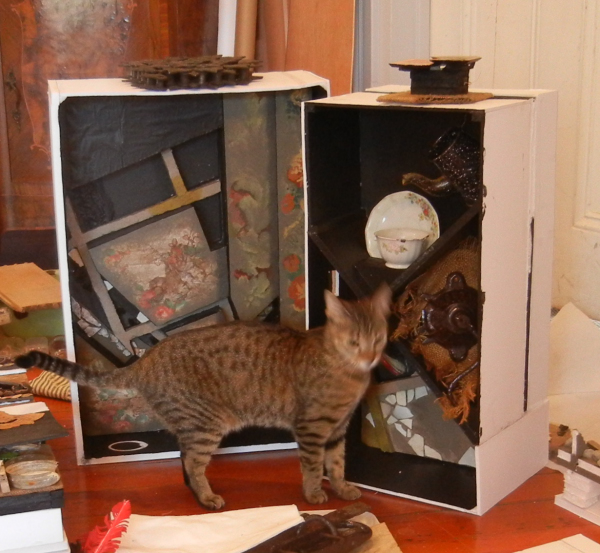
In the end, it was Liddubit who solved it. Simplicity itself, no design, no distraction. The tea pot pours into the cup with your Creole Belle in the background like a picture on the wall, a scene in a life. Then, you can partition off the grinder in the pointed section you can’t use for much else anyway, on a burlap-draped pedestal on its own like you’ve wanted it to be from the start . . . says she.
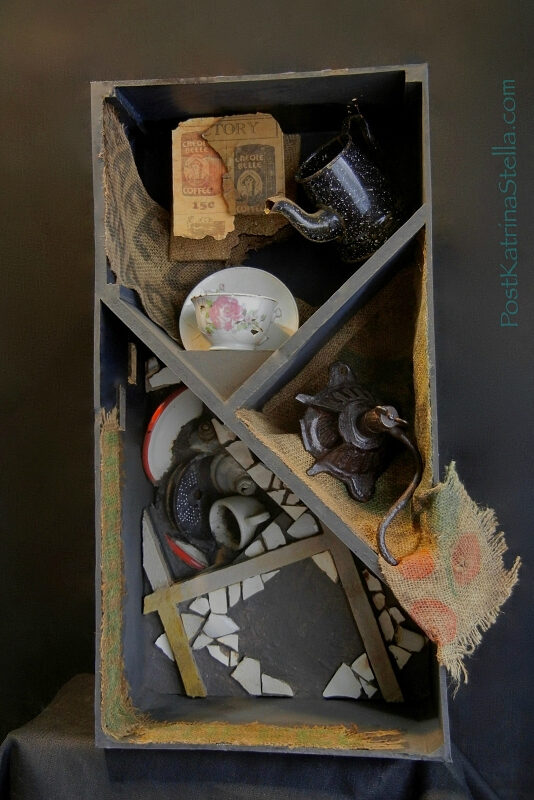
_________________________________________ Next up, “Kitchen” ________________________________________
